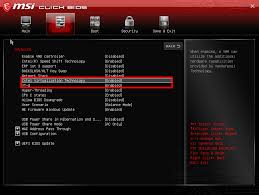Understanding Intel VT Technology
Intel Virtualization Technology (VT) is a set of hardware enhancements that allow better utilization of hardware resources by running multiple operating systems and applications on a single physical server. This technology has revolutionized the way virtualization is implemented in data centers and personal computing devices.
With Intel VT, virtual machines can run more efficiently and securely by providing direct access to the underlying hardware resources. This improves performance and reduces overhead, making virtualization more practical for various applications.
Main Features of Intel VT:
- Virtual Machine Monitor (VMM) Support: Intel VT includes hardware support for VMMs, enabling efficient management of virtual machines without affecting the performance of the host system.
- Extended Page Tables (EPT): EPT allows virtual machines to directly access physical memory, reducing memory management overhead and improving performance.
- Virtual Processor ID (VPID): VPID enables faster switching between virtual machines by providing unique identifiers for each virtual processor.
- I/O Device Virtualization: Intel VT supports efficient sharing of I/O devices among multiple virtual machines, enhancing flexibility and scalability.
Intel VT technology is widely used in server environments to consolidate workloads, improve resource utilization, and enhance security through isolation of virtual machines. It also benefits desktop users by enabling running multiple operating systems simultaneously without compromising performance.
In conclusion, Intel VT plays a crucial role in modern computing by enabling efficient and secure virtualization solutions. Its advanced features contribute to better performance, scalability, and flexibility in deploying virtualized environments across various platforms.
Top 5 Frequently Asked Questions About Intel VT Technology
- What is Intel VT?
- How does Intel VT improve virtualization performance?
- Which processors support Intel VT technology?
- Can I enable Intel VT in my computer’s BIOS settings?
- What are the benefits of using Intel VT in a virtualized environment?
What is Intel VT?
Intel Virtualization Technology (VT) is a suite of hardware enhancements developed by Intel that enables efficient utilization of hardware resources by running multiple operating systems and applications on a single physical server. This technology revolutionizes the field of virtualization by providing direct access to underlying hardware resources, thereby improving performance and reducing overhead. Intel VT facilitates the seamless operation of virtual machines, allowing for enhanced efficiency and security without compromising the performance of the host system. Its features such as Virtual Machine Monitor (VMM) support, Extended Page Tables (EPT), Virtual Processor ID (VPID), and I/O device virtualization make it an essential component in modern computing environments for achieving optimal resource management and scalability.
How does Intel VT improve virtualization performance?
Intel VT enhances virtualization performance by providing hardware-level support for virtualization tasks, reducing the overhead typically associated with software-based virtualization solutions. By offloading virtualization functions to the processor itself, Intel VT enables more efficient execution of virtual machines, allowing them to directly access hardware resources with minimal intervention from the host system. This results in improved performance, lower latency, and better utilization of system resources, ultimately leading to a smoother and more responsive virtualized environment. Intel VT’s advanced features like Extended Page Tables (EPT) and Virtual Processor ID (VPID) further optimize memory management and processor switching between virtual machines, contributing to overall enhanced virtualization performance.
Which processors support Intel VT technology?
Intel VT technology is supported by a wide range of Intel processors across different generations. Generally, most modern Intel Core processors, including Core i3, i5, i7, and i9 series, support Intel VT technology. Additionally, Xeon processors designed for server applications also come with robust support for virtualization through Intel VT. It is important to check the specific model and specifications of the processor to ensure that it includes Intel VT capabilities, as not all Intel processors may have this feature. By leveraging Intel VT technology, users can benefit from enhanced virtualization performance and efficiency on compatible processors.
Can I enable Intel VT in my computer’s BIOS settings?
Enabling Intel VT in your computer’s BIOS settings is a common query among users looking to utilize virtualization technology. To enable Intel VT, you typically need to access the BIOS setup during the boot process and navigate to the relevant settings section. However, it’s important to note that not all computers support Intel VT, especially older or lower-end models. In some cases, the option to enable VT may be disabled by default or may not be available at all in the BIOS settings. Therefore, before attempting to enable Intel VT, it’s advisable to check your computer’s specifications and consult the manufacturer’s documentation to ensure compatibility and availability of this feature.
What are the benefits of using Intel VT in a virtualized environment?
In a virtualized environment, utilizing Intel Virtualization Technology (VT) offers a multitude of benefits. One key advantage is improved performance and efficiency through optimized resource allocation, enabling multiple virtual machines to run seamlessly on a single physical server. Intel VT enhances security by providing hardware-level isolation between virtual machines, reducing the risk of data breaches and ensuring robust system integrity. Additionally, Intel VT simplifies the management of virtualized environments by streamlining tasks such as workload migration and resource scaling. Overall, the adoption of Intel VT in a virtualized setting leads to enhanced productivity, scalability, and reliability for both enterprise data centers and individual users seeking versatile computing solutions.
Tags: applications, data centers, desktop users, extended page tables ept, hardware enhancements, hardware resources, i/o device virtualization, intel virtualization technology, intel vt, isolation of virtual machines, modern computing, multiple operating systems, personal computing devices, physical server, resource utilization, security, server environments, virtual machines, virtual processor id vpid, virtualization solutions, vmm support
